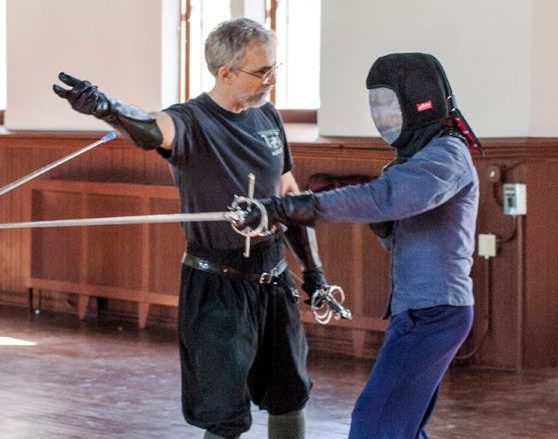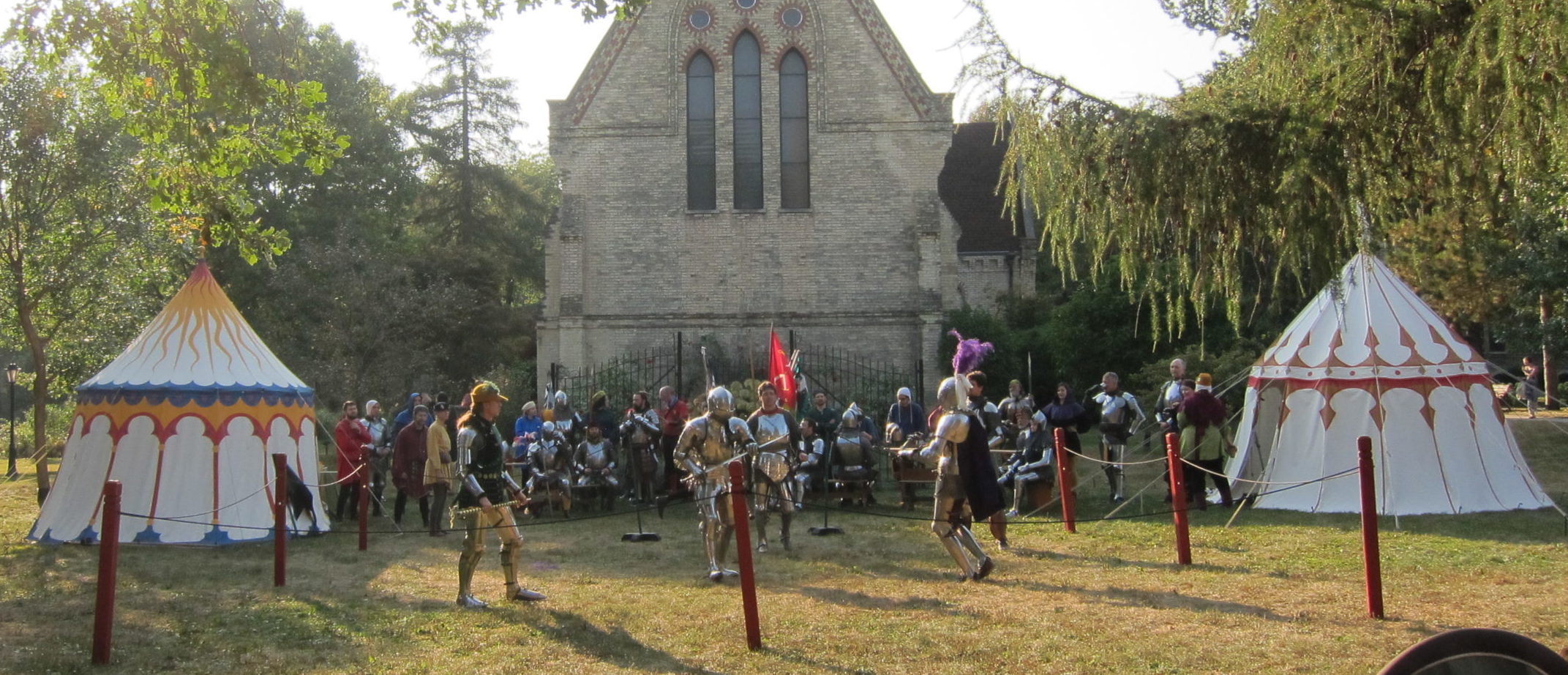
FENCING AND SPARRING
The chance to cross swords with fellow martial artists from around the world is one of the best reasons for coming to WMAW, and we want to make sure that everyone comes out of the weekend tired, but unscathed.
There are two types of fencing at the event – Coached and Free.
Free Fencing
Thursday and Friday evenings are for free-fencing. For most martial arts students, one of the key goals is to fight the way you train. This is never an easy task. This is even harder when training with weapons, since the dangers of fencing with weapons requires a great deal of safety rules, and therefore an even higher level of artificiality.
In order to help students work to both “keep it real” and “keep it clean”, each evening will begin with a 90 minute block of Coached Fencing.
After the 90 minute Coached Fencing block is over, the floor is open for free-fencing until the Great Hall closes for the evening.
Please note that all Coached and Free Fencing bouts are subject to the general safety guidelines.
Coached Fencing
Our instructors have volunteered their time to work with pairs of students to help them refine their combat skills. Here’s how it works.
There will be a list in each attendee’s Event Book of which instructors are available on Thursday and/or Friday evening, and which weapons/styles of combat they are providing coaching. Students should find a partner and approach the Floor Monitor, informing them of what style they want help with (German longsword, Italian rapier, dueling saber, etc), and they will be assigned to a coach.
They will have that coach’s undivided attention work for about 15 minutes of coached fencing (obviously this can be longer, if no one is waiting, but they are guaranteed 15 minutes).
Free-Fencing Conduct & Equipment Standards
One of the Western Martial Arts Workshop’s highlights is crossing swords with fellow martial artists from around the world. The same diversity of equipment, methodology, and skill that makes this experience so enjoyable also presents the host a challenge to insure that basic safety standards are met. Fencing with weapons is a privilege, and we have found that the best safety measures are the following:
- Control
- Control
- Control
There is no substitute for control, trust and mutual respect between partners. Safety equipment only serves to reinforce these basic qualities. The WMAW Steering Committee and the Chicago Swordplay Guild assumes it guests will acquit themselves accordingly, and will fence based upon whatever conventions they have mutually agreed upon, as long as these comply with the basic safety guidelines below.
Therefore, the only specific limitations on technique are as follows:
- Deliberate attack of any kind to the knees or to any unarmoured parts of the head and neck are forbidden.
- Thrusts with non-flexible weapons shall always be pulled.
- Grappling is meant to be used as an adjunct to the weapon. Therefore any grapple where one combatant has not scored a hit or established a significant advantage (e.g. disarm or potential throw) within three seconds of the first grappling move, is deemed to stop the fight. The combatants shall break and resume their ward before continuing.
- There is no un-monitored, grappling free-play provision at this event!
Please read the rest of the safety guidelines carefully, and remember – you fence at this event as a privilege, but upon your own honor and risk – neither WMAW Steering Committee, the Chicago Swordplay Guild, or the DeKoven Foundation assume responsibility for any injuries that may occur.
Conduct
Free-fencing will only occur in the designated areas and times.
Combatants will remain in control of themselves and their tempers at all times.
Combatants will have their weapons and equipment inspected by the Monitor before taking the field.
If a combatant leaves the field to get a new weapon, they will have that weapon inspected by the Monitor.
No one shall interfere in a combat in which they are not involved, with the exception of a Monitor acting within their official capacity, unless they are prepared to justify their actions to the Monitors.
No combatant shall deliberately attempt to injure any other combatant, and every attempt shall be made to avoid accidental injury.
No combatant shall handle or use another combatant’s equipment without their permission
No combatant shall act irresponsibly with a weapon at any time during or outside a group event.
Combat will cease immediately should a Monitor or Instructor call Halt or Hold!
The Monitor will not judge or preside over fencing, but reserves the right to stop any bout at any time if they consider that one or both of the combatants to be fighting dangerously, to be contravening these rules, or to be using any item of equipment that is unsafe.
Any combatant known or suspected of being under the influence of any intoxicating drug (including alchohol) will be barred from taking part in combat whilst under the influence of that drug. Furthermore, anyone suspected of attempting to fight while under the influence of an intoxicating drug may be barred from further participation at the Western Martial Arts Workshop, at the discretion of the Safety Officer and Event Chair.
The Monitors, Coaching Instructors and WMAW Staff reserve the right to remove any combatant from the list for any violation of these rules or anything they believe constitutes a safety risk.
Weapons and Safety Gear Specifications
In addition to these three, critical components equipment standards form the final tier of defense when fencing. The following weapons and safety equipment specifications are the baseline requirements for free-fencing at WMAW 2019. They have been developed from conversations with other active historical fencing academies and schools, and have been designed to take into account the different forms of fencing practiced throughout the community. Combatants will be expected to comply with these rules in order to free-fence.
Each free-fencing area will have a Monitor in charge of equipment inspection and ensuring that the safety rules are adhered to.
All weapons & equipment must be inspected and approved by the Monitor prior to fencing.
As this is a historical western martial arts workshop, all weapons should be constructed in as historically accurate a manner as possible within the realm of safety. Free-play with other sorts of weapons (e.g. Asian or improvised weapons) is inappropriate at this event. All weapons should be in good repair, and should remain so for the duration of the event. It is the fencer’s responsibility to check his or her weapons diligently, and fix or remove them from use if the have burrs, rust, splinters or cracks.
Contact Weapons
This category refers to weapon simulators specifically designed for “full-contact” fencing.
- Padded Weapons (Padded weapons should approximate the weight and balance of a real weapon, and should be in good repair.
- Shinai Weapons All such weapons must be mounted in a western-style hilt. The shinai core should be in good repair, free of cracked slats or splinters.
Wooden Weapon Specifications
- All wooden weapons (wasters, singlesticks, staves) will be in good repair, with no splinters or cracks.
- Singlesticks shall have their basket hilts attached in such a way that the blade cannot come detached from the hilt while being used.
- Any weapons that become splintered or cracked will be removed from use immediately.
Steel Weapon Specifications
- All weapons will be in good repair, with their hilts solidly attached, and have their blades free of burrs, cracks, or burrs.
- All steel cutting swords should have an edge that is a minimum of 1.5mm wide, with a well-rounded point (roughly the minimum diameter of an American dime).
- Edges should be rounded, not squared.
- The weapon’s weight should approximate that of its historical counter-part.
- Blades may have only a single, gradual curve.
- Thrusting swords (rapiers, small swords, epée du combat) should be neither too stiff (rigid) nor overly flexible (whippy), subject to the discretion of the Monitor.
- The point of rapiers, spadroons and small swords must be covered with a standard of a rubber “archery blunt” well secured to the blade with adhesive tape or its equivalent, such as a winding of waxed thread covered with adhesive tape and then covered with a leather patch or rubber coating.
- The point of epée-bladed weapons should have a standard fencing blunt attached at all times.
- Free-play with steel poleaxes or mass weapons is strictly prohibited.
Protective Equipment Specifications
The following equipment is required for all free fencing:
- No bare flesh may be exposed. Long pants or the equivalent (such as knickers with high socks or boots) must be worn and must be of a strong, tight weave, non-stretch material. No bare flesh may be exposed.
- Breast protectors (either commercial or equivalent) are required for women, and rigid groin cups (commercial) are required for men.
- A minimum of 3-weapon fencing masks (12 Kg Punch test) with thick, sewn-in bibs are required. For wooden or steel weapons, a solid steel helmet that covers the entire head and face that protects the head is strongly recommended.
- Extra protection for the throat, such as a gorget made of steel or leather that covers the cervical vertebrae and collar bones is required.
- Body protection should be worn for all but padded weapons. Standard three-weapon uniforms or equivalent protection are considered the minimum protective clothing . Uniforms must be made of strong material, preferably of heavily padded cotton duck or canvas. For heavier, wooden or steel weapons, some sort of body armour such as a gambeson, buff-coat or brigadine, or equivalent shall be worn.
- Heavy leather gloves, padded saber gloves, or the equivalent, are required for both hands when fencing with padded weapons, rapiers and light weapons (such as smallswords, classical fencing weapons, etc.) .
- Basket hilts or gauntlets shall protect the hands. Modern street-hockey gloves are acceptable as a basic level of protection.
- A heavy leather vambrace, or equivalent, to protect the forearm is recommended for fencing with steel and wooden weapons.
- Rigid protection for the elbows and knees is strongly recommended when fencing with steel and wooden weapons.

